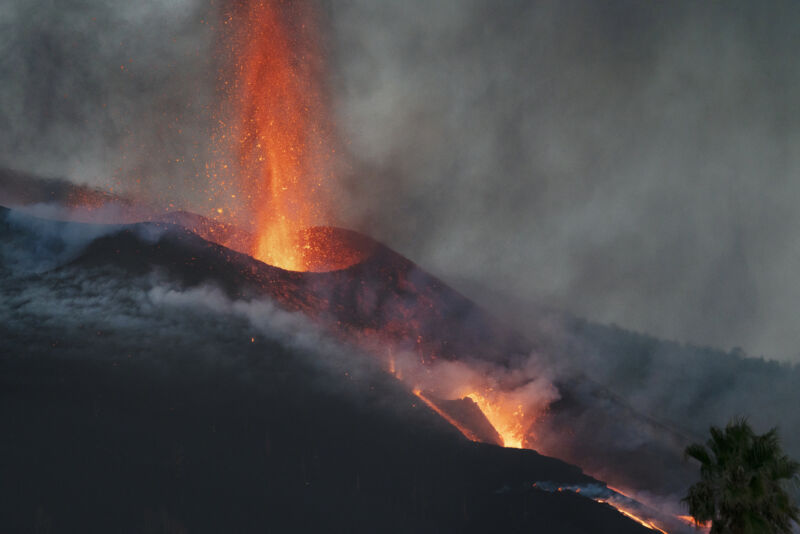
Last fall’s Cumbre Vieja volcanic eruption in the Canary Islands was surprising for several reasons. Most predominantly, the eruption did not cause tsunamis to spread across the Atlantic Ocean, as some experts had predicted. But for volcanologists, the eruption displayed several other unexpected features that may help experts better forecast which volcanos are most at risk of calamitous eruptions, allowing for better long-term planning for La Palma and similar volcanic regions.
Researchers are still in the early phases of analyzing the wealth of data they collected during the nearly three-month-long eruption (85 days and eight hours, to be precise). But as highlighted in a recent perspective article, the eruption may answer a number of ongoing questions while raising several new ones—particularly about its surprise finale.
Rare learning opportunity
The 2021 Cumbre Vieja eruption lasted longer and produced more lava (over 200 million m3) than any other in La Palma’s recorded history. This long duration, combined with the relatively convenient location of the Canary Islands, provided a rare opportunity for researchers around the world to study the volcano’s progress in detail. The observations included geophysical and geochemical measurements—before, during, and after the eruption—as well as insights into the magma flow below ground and the lava paths above.
According to Pablo J. González, a geodynamics researcher at the Estación Volcanológica de Canarias and author of the perspective article, this data could transform risk assessment and planning for the islands and other volcanic areas.
“There are multiple ways in which this eruption and the data collected will contribute to a better assessment of future volcanic hazards in the Canary Islands,” González told Ars. “[This includes] refining the prediction of the lava flow pathways and how those lava flows interact with infrastructure or objects (e.g., banana plantations and their plastic covers) and improving land planning permissions and the placement of critical infrastructure (roads, factories, harbors, etc.).”
Toxic gases from the combustion of buildings and materials caused significant additional hazards. Another key piece of new safety information came from measuring which gases were emitted, and in what quantities, as the lava moved across the landscape and met the sea.
The behavior of the eruption was also unexpected in several ways. Cumbre Vieja’s island location and steep slopes fit the profile of catastrophic tsunami-causing eruptions, such as the one at Anak Krakatau. Several researchers had forecasted potential tsunamis from a Cumbre Vieja eruption—both near and far from the island—but that didn’t come to pass. Why not?
No collapse this time
In short, researchers don’t yet know. Cumbre Vieja had several of the characteristic signatures of other volcanos like Anak Krakatau and Mount St. Helens, both of which experienced catastrophic flank collapses in which the side of the volcano gave way and led to extensive landslides. The slopes at Cumbre Vieja had been rapidly growing over the last 150,000 to 125,000 years and had begun to show signs of instability—fractures, fissures, and faults—over the last 7,000 years.
But there were no collapses during the latest eruption. Instead, in the final weeks of the eruption, fractures and a new fissure system split open the side of the volcano. In just two days, a 100-meter-tall cone grew near the summit, and transient vents appeared across the slope.
“The appearance of large cracks perpendicular to the volcano slopes on its Western flank was very unusual. However, it is still not clear what they mean,” writes González. “We will have to research them in the coming years to fully understand why they form and whether they are a way for the volcano to release magma pressure or something else.”
This latest eruption has provided researchers with plenty of data and questions to explore in the coming years, and the answers will hopefully help experts make better predictions about future volcanic risks.
“The low recurrence eruption rate in the Canary Islands volcanoes made it very difficult to know the full extent of volcanic activity and its effects on the population,” wrote González. “Documenting and investigating those effects on a real eruption is what makes it possible to make progress and be better prepared for future events. Each eruption... makes it [possible to] better understand them.”


3175x175(CURRENT).thumb.jpg.b05acc060982b36f5891ba728e6d953c.jpg)

Recommended Comments
There are no comments to display.
Join the conversation
You can post now and register later. If you have an account, sign in now to post with your account.
Note: Your post will require moderator approval before it will be visible.